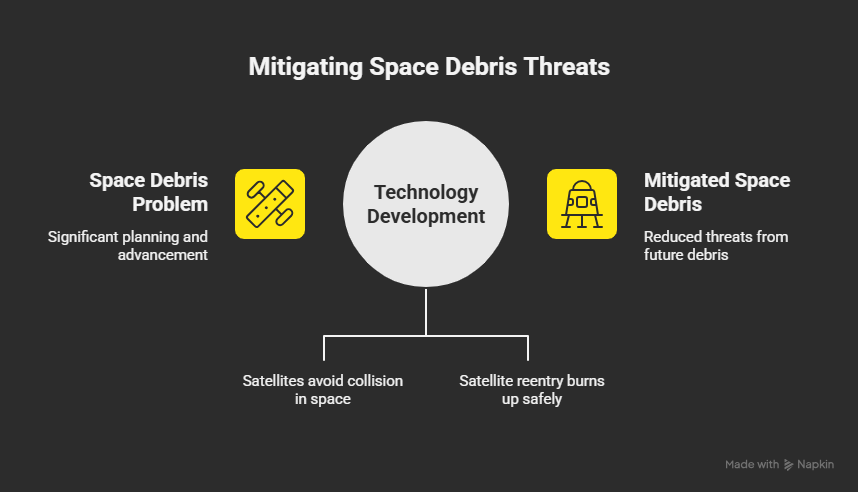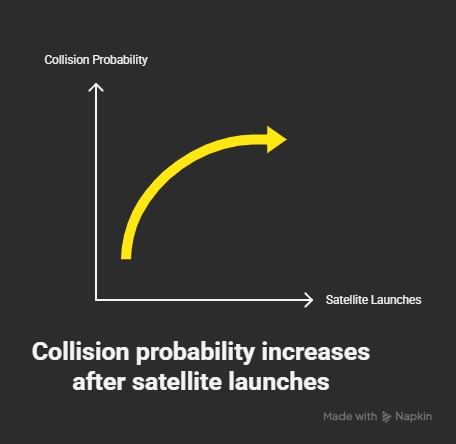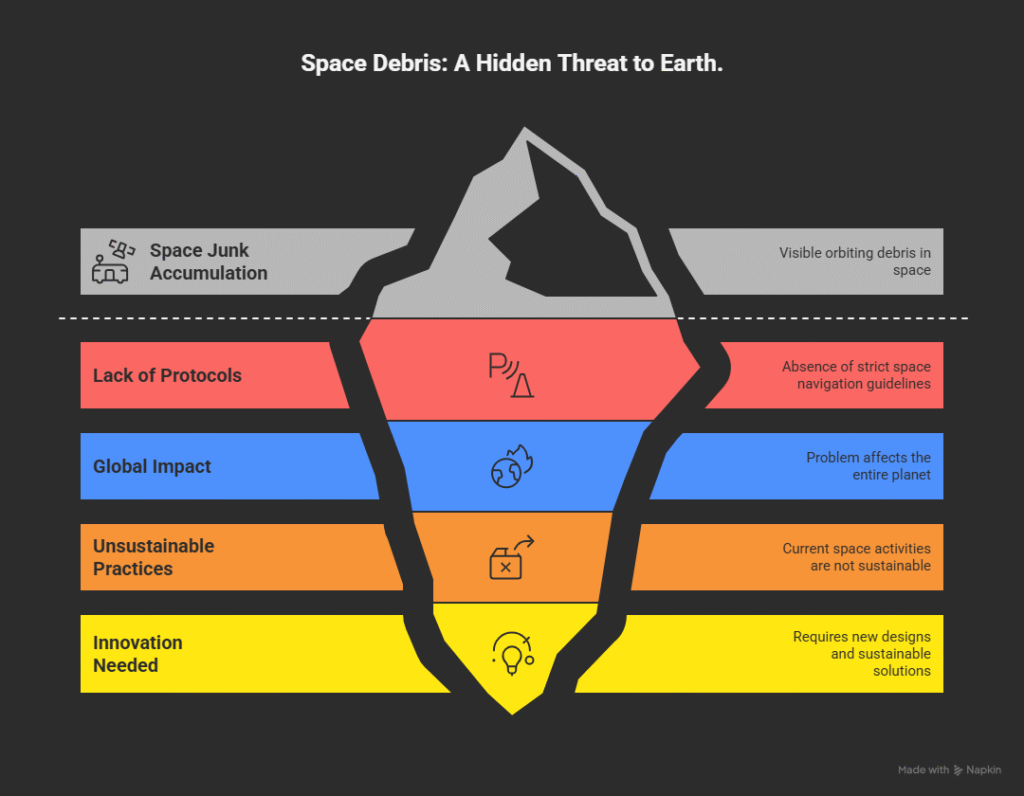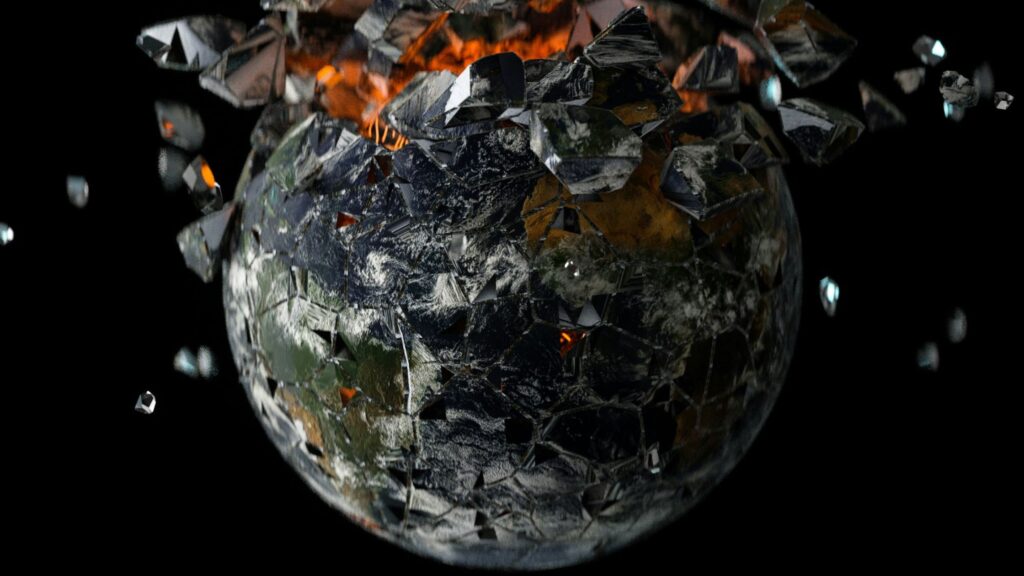Space is full of interesting objects, celestial bodies and many other unexplored wonders. However, debris is the last thing that comes to mind when we think about outer space. But in reality, there are over 9000 metric tons of junk orbiting our planet—some of which poses a threat to satellites, telescopes and spacecraft in orbit. Again, most of this comes from the human activities of space exploration, communication development and spacecraft. So, does space debris pose a problem to human beings? Let’s explore more about the situation and how we can tackle it in the future.
More About Space Debris?
Space debris is composed of everything that orbits space. It can be man-made or natural, and both types can affect the future space programs. Moreover, it can range from a few millimetres to a large apartment. So, the spectrum is very long when we talk about debris in space.
- Defunct satellites.
- Meteorites.
- Small rocks.
- Comet particles.
- Rocket stages.
- Fragmentation debris.
- Tiny particles like paint flecks.
The natural debris, which mainly consists of meteoroids, is also a huge problem. However, it is not in our hands to maintain it. At the same time, human efforts and sustainable practices can reduce man-made junk to normal levels. So, let’s see how scientists and engineers can resolve or mitigate the issue.
The Amount of Debris
There is a lot of junk revolving around the Earth’s orbit, and it’s no surprise that it is increasing day by day. Most of the numbers are tracked by NASA and ESA with relevance and precision. Additionally, all the agencies differentiate the debris based on its size. It is crucial since size matters for spacecraft and other celestial missions. Even though small debris is in larger quantities, it is as dangerous for any satellite or telescope as large debris.
- Large debris (>10 cm)
- Medium debris (1–10 cm)
- Small debris (<1 cm)
Note: The majority of debris is not even tracked yet, and some may even travel faster than the speed of bullets in lower Earth orbit.
Multiple Reasons for the Increase in Space Debris
There are multiple reasons for the increase in space junk, and most of it is man-made. Although the natural reasons also contribute, they are beyond the scope of human control. So, here are the six reasons that primarily contribute to the debris in outer space.
- Satellite decommissioning without proper disposal.
- Rocket launches and spent stages.
- Accidental collisions between satellites.
- Intentional destruction—anti-satellite missile tests.
- Breakups caused by explosions (fuel tanks, batteries).
- Meteoroids enter the Earth’s orbit.
The Risks and Dangers of Space Debris
This debris poses numerous problems to human society. First of all, it can hinder communication, navigation and weather forecast. At the same time, it can cause significant losses to companies and agencies. And even though the chances of debris reaching and colliding are small, there’s always a chance that it might cause further loss of lives or property.
- Problem with operational satellites.
- Threat to the International Space Station.
- Hazards for future space exploration.
- Economic losses and more.
Tracking and Monitoring Space Debris With Latest Technologies
Many space agencies are working to monitor space debris using the best technology. This mainly includes ground-based radar and optical telescopes. The first step is to find the amount of debris and then further develop strategies to reduce it. Thus, it can help to calculate collision probabilities and help to navigate spacecraft accordingly.
- NASA’s ODPO.
- ESA’s Space Debris Office.
- US Space Command.
Developing Solutions to the Space Debris Problem
The current technology requires significant planning and advancement to address the space debris problem effectively. It all starts with developing manoeuvring technologies in satellites to avoid collision. There is also a need to create integrated burn-up technology upon satellite reentry. Then there is only a chance to mitigate the posed threats of future space debris.

Innovative Debris Removal Technologies
Below are some of the most advanced debris removal technologies to overcome the problem of space junk. However, most of these technologies are in the development phase and require significant advancements to improve their performance.
- Nets, harpoons, robotic arms.
- Laser systems to push debris into decay orbits.
- Electrodynamic tethers.
- Magnetic capture systems.
- Active debris removal missions.
Policies, Laws, and International Cooperation To Overcome Space Debris
Rules and regulations are fundamental to follow for improving any facet of human existence. The same goes for overcoming the problem of space debris. The space agencies need to unite and address the situation to come up with proper resolutions. Then, only anything worthwhile can be done to prevent the further escalation of the issue. Thus, it all starts with initiatives that are then converted into policies for sustainable space exploration and less polluting space missions.
- Outer Space Treaty.
- UN space debris mitigation guidelines.
- National regulations and compliance challenges.
- Global cooperation and shared responsibility.
The Future of Space Debris
With the increase of junk in space, the situation will only worsen. You can find an increase in the probability of collision after satellite launches. As a result, the Kessler Syndrome might become a reality in the future. If something like this happens, there’s a chance that space will become unusable for decades to come and thus limit the capacity of humanity’s exploration of space.

Final Thoughts on Space Debris
The accumulation of junk and debris in space is a serious issue that requires immediate attention from all space agencies worldwide. It’s not only what’s orbiting the atmosphere but also what is getting into the orbits. That’s why the world needs strict protocols and guidelines when navigating around the Earth. Moreover, it’s not the problem of particular space agencies alone, as it affects the entire planet. Thus, sustainable practices and innovation in design are necessary to solve this problem.

FAQs
How is the ISS protected from space debris?
The ISS is equipped with a Whipple shield, which helps to prevent damage upon collision with meteors and debris.
Why is space debris a problem?
It can jeopardise the structure of the spacecraft and cause severe damage to crucial parts.
How to clean space debris?
It’s tough to get rid of debris in space. One way is to push or pull it to lower orbits and manoeuvre its path towards the oceans.
What is the 25-year rule in space?
This rule safeguards the orbit from debris accumulation. The different orbiting satellites are calibrated to move to the graveyard after 25 years.
Has space debris hit anyone?
Although getting hit with space debris is rare, there is a possibility that it can strike people or objects on Earth.
How much junk is in space?
There is an estimate of over 9000 metric tons of debris orbiting the Earth.

